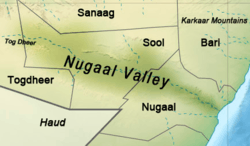Nugaal Valley
| Nugaal Valley | |
|---|---|
 | |
| Long-axis direction | West-East |
| Long-axis length | 250 kilometres (160 mi) |
| Width | 10 to 100 kilometres (6.2 to 62.1 mi) |
| Geography | |
| Coordinates | 8°27′42.41″N 48°3′15.12″E / 8.4617806°N 48.0542000°ECoordinates: 8°27′42.41″N 48°3′15.12″E / 8.4617806°N 48.0542000°E |
The Nugaal Valley (Somali: Dooxada Nugaal, Arabic: وادي نوجال), also called the Nogal Valley, is a long and broad valley located in northern Somalia.[1]
Overview
The Nugaal Valley is a key pastoral area which spans across four regions, Nugaal, Sool, Sanaag and Togdheer.[2] Pastoral nomadism is the primary way of life for most of the people living in the valley. Goat and camel raising form the basis of the economy, and frankincense and myrrh are collected from wild trees. The beds of the watercourses have a few permanent wells, to which the predominantly nomadic population returns during the dry season. Low and erratic rainfall (about 5 inches 125 mm annually) and the high salinity of the soil limit crop cultivation.[3]
Geography
Extending 250 km along the Wadi Nugaal, the Nugaal Valley is bounded by gradually ascending high plateaus that generally reach elevations of 1,650 to 3,300 feet (500 to 1,000 m) above sea level on the north, west, and south. The western part of the same plateau is crossed by numerous valleys and dry watercourses. The same plateau sloping southwards merges with Hawd, a plain known for its grasslands. To the east is a narrow strip of low-lying maritime plains.
The valley's principal watercourses, the Nugaal and the more westerly Dheere, fill briefly during and after rainstorms (April to June) and drain into the Indian Ocean. The upper part of the Nugaal is filled by the seasonal river known as Tog Dheer.
Flora and fauna

The main vegetation in Nugaal valley consists of open grasslands, shrubs (commiphora spp), Acacia trees and dominant grasses (indigofera spp). The valley is home to succulent flora and is particularly rich in local endemics. Gypsum hills located around Las Anod supports flora such as Aloe inermis, Dorstenia, Adenia, Raphanocarpus, Euphorbia, Pterodiscus, and Caralluma.
A Las Anod National Park has been proposed to protect the fine scenery, rich and varied flora, and the Somali Wild Ass. The limestone plateau north of Eyl has also been proposed as a national park due to its rich endemic flora.[4]
Oil exploration
Due to its proximity to the oil-rich Gulf Arab states such as Saudi Arabia and Yemen, the nation has also long been believed to contain substantial unexploited reserves of crude oil. Nugaal Valley Block has been identified as having reservoir, source rock and trap potential. International oil and gas companies conducted exploration in the late 1980s in the region. During this exploration phase, a grid of 2D seismic was shot perpendicular to the axis of the rift system in the Nugaal Basin. Based on interpreted maps this data shows a number of large, closed, fault-controlled structures.[5]
Between them both, the Nugaal and Dharoor valley have only had 5 wells drilled, making the area one of the least explored areas in North Africa.[6]
See also
References
- ↑ Metz, Federal Research Division, Library of Congress ; edited by Helen Chapin (1993). Somalia a country study (4th ed.). Washington, D.C.: U.S. G.P.O. p. 106. ISBN 0844407755.
- ↑ "ReliefWeb". OCHA. Retrieved 15 May 2013.
- ↑ "Nugaal Valley". Britannica. Retrieved 15 May 2013.
- ↑ Cactus, compiled by Sara Oldfield ; IUCN/SSC; Group, Succulent Specialist (1997). Cactus and succulent plants : status survey and conservation action plan. Gland, Switzerland: IUCN. p. 59. ISBN 2831703905.
- ↑ "Horn Petroleum". Horn Petroleum. Retrieved 16 May 2013.
- ↑ "Africa Oil". Africa Oil. Retrieved 16 May 2013.